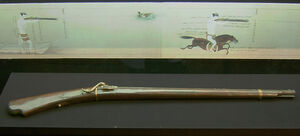
The arquebus (pronounced /ˈɑrkɨbʌs/ AR-kə-bus or /ˈɑrkwɨbʌs/ AR-kwə-bus) (sometimes spelled harquebus, harkbus or hackbut; from Dutch haakbus, meaning "hook gun") or "hook tube", is an early muzzle-loaded firearm used in the 15th to 17th centuries. The word was originally modelled on the German: Hakenbüchse, this produced haquebute. It then copied the Italian word: archibugio; which gave arquebuse (French), arcabuz (Spanish) and arquebus (English) In distinction from its predecessor the hand cannon, it has a matchlock. Like its successor the musket, it is a smoothbore firearm, but it is lighter and easier to carry.
It is a forerunner of the rifle and other longarm firearms. An improved version of the arquebus, the caliver, was introduced in the early 1500s. The word is derived from the English corruption of calibre as this gun was of standard bore, increasing combat effectiveness as troops could load bullets that would fit their guns (before, they would have to modify shot to fit, force it in or cast their own before the battle).
Heavy arquebuses mounted on wagons were called arquebus à croc. These carried a ball of about 3.5 ounces.
Arquebus in 1632[]
The arquebus was the predominant firearm of the various militaries of Europe during the Thirty Years' War. After the Ring of Fire, the arquebus was rendered completely obsolete by the firearms used by the people of Grantville. The arquebus' terrible inaccuracy, relatively short effective range, and slow reloading allowed the Grantvillers to outshoot any enemy on the battlefield. The later introduction of rifled flintlock muskets and the French "Cardinal" breechloaders sealed the obsolescence of the arquebus.